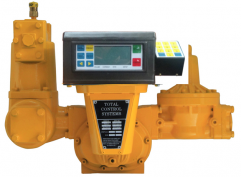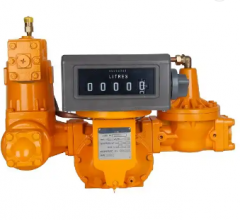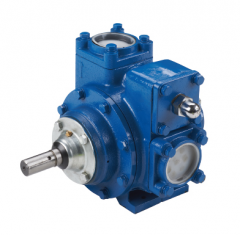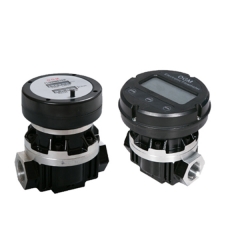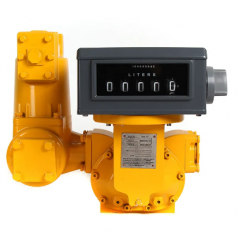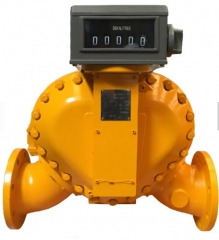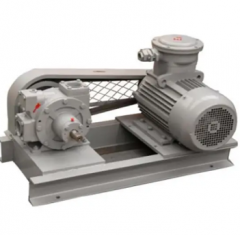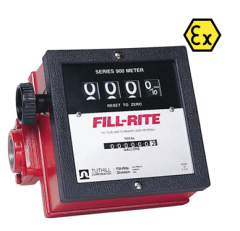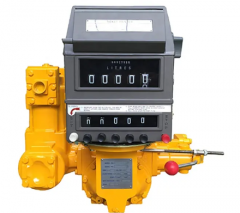- Description
Vane Pump Overview
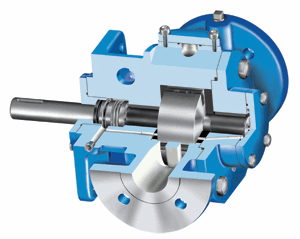 While vane pumps can handle moderate viscosity liquids, they excel at handling low viscosity liquids such as LP gas (propane), ammonia, solvents, alcohol, fuel oils, gasoline, and refrigerants. Vane pumps have no internal metal-to-metal contact and self-compensate for wear, enabling them to maintain performance on these non-lubricating liquids. Though efficiency drops quickly, they can be used up to 500 cPs / 2,300 SSU.
While vane pumps can handle moderate viscosity liquids, they excel at handling low viscosity liquids such as LP gas (propane), ammonia, solvents, alcohol, fuel oils, gasoline, and refrigerants. Vane pumps have no internal metal-to-metal contact and self-compensate for wear, enabling them to maintain performance on these non-lubricating liquids. Though efficiency drops quickly, they can be used up to 500 cPs / 2,300 SSU.
Vane pumps are available in a number of vane configurations including sliding vane (left), flexible vane, swinging vane, rolling vane, and external vane. Vane pumps are noted for their dry priming, ease of maintenance, and good suction characteristics over the life of the pump. Moreover, vanes can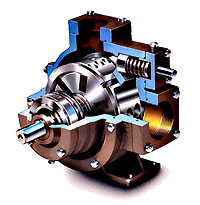 usually handle fluid temperatures from -32�C / -25�F to 260�C / 500�F and differential pressures to 15 BAR / 200 PSI (higher for hydraulic vane pumps).
usually handle fluid temperatures from -32�C / -25�F to 260�C / 500�F and differential pressures to 15 BAR / 200 PSI (higher for hydraulic vane pumps).
Each type of vane pump offers unique advantages. For example, external vane pumps can handle large solids. Flexible vane pumps, on the other hand, can only handle small solids but create good vacuum. Sliding vane pumps can run dry for short periods of time and handle small amounts of vapor.
Despite the different configurations, most vane pumps operate under the same general principle described below.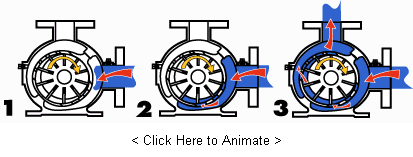
1. A slotted rotor is eccentrically supported in a cycloidal cam. The rotor is located close to the wall of the cam so a crescent-shaped cavity is formed. The rotor is sealed into the cam by two sideplates. Vanes or blades fit within the slots of the impeller. As the rotor rotates (yellow arrow) and fluid enters the pump, centrifugal force, hydraulic pressure, and/or pushrods push the vanes to the walls of the housing. The tight seal among the vanes, rotor, cam, and sideplate is the key to the good suction characteristics common to the vane pumping principle.
2. The housing and cam force fluid into the pumping chamber through holes in the cam (small red arrow on the bottom of the pump). Fluid enters the pockets created by the vanes, rotor, cam, and sideplate.
3. As the rotor continues around, the vanes sweep the fluid to the opposite side of the crescent where it is squeezed through discharge holes of the cam as the vane approaches the point of the crescent (small red arrow on the side of the pump). Fluid then exits the discharge port.
- Aerosol and Propellants
- Aviation Service - Fuel Transfer, Deicing
- Auto Industry - Fuels, Lubes, Refrigeration Coolants
- Bulk Transfer of LPG and NH3
- LPG Cylinder Filling
- Alcohols
- Refrigeration - Freons, Ammonia
- Solvents
- Aqueous solutions
Materials Of Construction / Configuration Options
- Externals (head, casing) - Cast iron, ductile iron, steel, and stainless steel.
- Vane, Pushrods - Carbon graphite, PEEK�.
- End Plates - Carbon graphite
- Shaft Seal - Component mechanical seals, industry-standard cartridge mechanical seals, and magnetically-driven pumps.
- Packing - Available from some vendors, but not usually recommended for thin liquid service
 USD
USD EUR
EUR GBP
GBP CAD
CAD AUD
AUD CHF
CHF HKD
HKD JPY
JPY RUB
RUB BRL
BRL CLP
CLP NOK
NOK DKK
DKK SEK
SEK KRW
KRW ILS
ILS MXN
MXN CNY
CNY SAR
SAR SGD
SGD NZD
NZD ARS
ARS INR
INR COP
COP AED
AED
